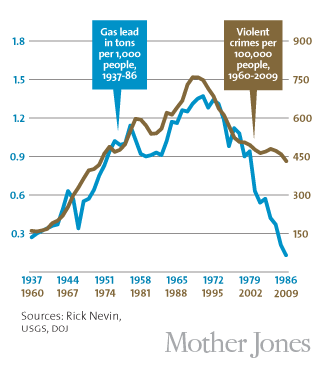Violent crime has dropped significantly since the mid-90's. In New York, it's down 75 percent. Dallas' has fallen 70 percent. Newark: 74 percent. Los Angeles: 78 percent. Washington DC: 58 percent.
Why?
Conventional wisdom is that crime rates drop when the economy gets better. Therefore, violent crime rates drop with the overall decrease in all crimes.
But that doesn't seem to explain this phenomenon. Violent crime rates have continued to plunge in good economic times and in recessionary times.
Other theories? Better policing tactics. The transition in inner cities from heroin to crack to marijuana. One theory suggests that Roe v Wade is a factor: less unwanted babies mean less maladjusted young men, and therefore less violent crime.
The problem is that with each theory, it is hard to tease out actual proof.
Over at Mother Jones, Kevin Drum puts forth a theory for which they is at least coincidental proof: Violent crimes have gone down because of Pb(CH2CH3)4.
Lead.
You should read the whole article, but the premise is this: as society has moved from leaded gasoline to unleaded gasoline, violent crime rates have gone down.
Coincidence? Maybe. But Drum discusses one researcher who discovered that:
this reduction wasn't uniform. In fact, use of leaded gasoline varied widely among states, and this gave Reyes the opening she needed. If childhood lead exposure really did produce criminal behavior in adults, you'd expect that in states where consumption of leaded gasoline declined slowly, crime would decline slowly too. Conversely, in states where it declined quickly, crime would decline quickly. And that's exactly what she found.
Other countries, at different times, also transitioned from leaded gasoline to unleaded gasoline.
Sure, maybe the real culprit in the United States was something else happening at the exact same time, but what are the odds of that same something happening at several different times in severaldifferent countries?
Nevin collected lead data and crime data for Australia and found a close match. Ditto for Canada. And Great Britain and Finland and France and Italy and New Zealand and West Germany. Every time, the two curves fit each other astonishingly well. When I spoke to Nevin about this, I asked him if he had ever found a country that didn't fit the theory. "No," he replied. "Not one."
Then there's this:
For example, murder rates have always been higher in big cities than in towns and small cities. We're so used to this that it seems unsurprising, but Nevin points out that it might actually have a surprising explanation—because big cities have lots of cars in a small area, they also had high densities of atmospheric lead during the postwar era. But as lead levels in gasoline decreased, the differences between big and small cities largely went away. And guess what? The difference in murder rates went away too. Today, homicide rates are similar in cities of all sizes. It may be that violent crime isn't an inevitable consequence of being a big city after all.
So decreases in atmospheric lead, from car exhaust etc., coincide with decreases in the violent crime rate.

Is there any biology to explain the connection?
Why, yes.
Lead is a double whammy: It impairs specific parts of the brain responsible for executive functions and it impairs the communication channels between these parts of the brain. For children like the ones in the Cincinnati study, who were mostly inner-city kids with plenty of strikes against them already, lead exposure was, in Cecil's words, an "additional kick in the gut." And one more thing: Although both sexes are affected by lead, the neurological impact turns out to be greater among boys than girls.
Other recent studies link even minuscule blood lead levels with attention deficit/hyperactivity disorder. Even at concentrations well below those usually considered safe—levels still common today—lead increases the odds of kids developing ADHD.
In other words, as Reyes summarized the evidence in her paper, even moderately high levels of lead exposure are associated with aggressivity, impulsivity, ADHD, and lower IQ. And right there, you've practically defined the profile of a violent young offender.
There still is a huge lead problem in this country. Yes, it has been banned in gas since 1996, but guess what:
As it turns out, tetraethyl lead is like a zombie that refuses to die. Our cars may be lead-free today, but they spent more than 50 years spewing lead from their tailpipes, and all that lead had to go somewhere. And it did: It settled permanently into the soil that we walk on, grow our food in, and let our kids play around…
Lead in soil doesn’t stay in the soil. Every summer, like clockwork, as the weather dries up, all that lead gets kicked back into the atmosphere in a process called resuspension. The zombie lead is back to haunt us.
This is a public health issue that money and elbow grease can fix.
And it more than pays for itself, in dollars and shattered lives.

